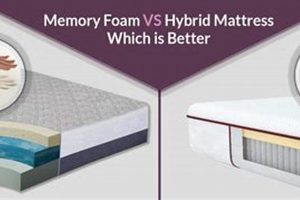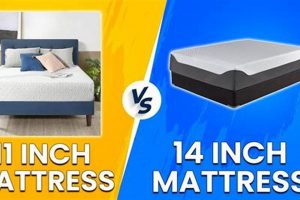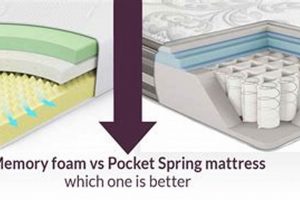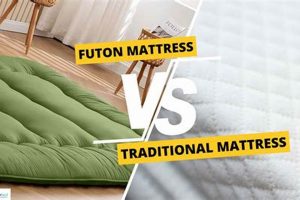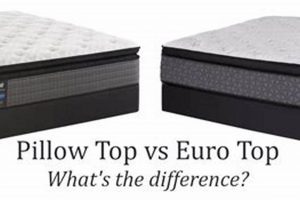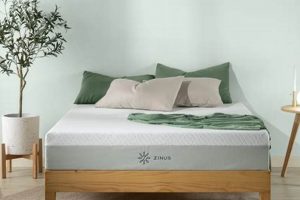The selection of appropriate bedding is crucial for comfort and adequate sleep, particularly when space is a constraint. A key consideration arises when choosing between a recreational vehicle (RV) queen mattress and a standard queen mattress. The former is specifically designed with dimensions that often differ from its residential counterpart, primarily to accommodate the unique layouts and spatial limitations inherent in RV interiors. Examples of these differences include shorter lengths or narrower widths to facilitate movement and appliance placement within the vehicle.
The significance of choosing the correct mattress type extends beyond mere physical fit. Selecting the appropriate mattress ensures optimal use of limited space, thereby enhancing the overall functionality and livability of the RV. Historically, RV manufacturers have prioritized space efficiency, leading to specialized dimensions in appliances and furnishings, including mattresses. This focus directly impacts comfort levels and the practical application of the living area.
This article will delve into a detailed comparison of these two mattress types, focusing on dimensional variations, construction materials, comfort considerations, and the overall impact on sleep quality within the context of RV travel. Further exploration will also address the available options and important factors to consider when making a purchase decision.
Important Considerations for RV and Standard Queen Mattresses
When evaluating mattresses, particularly for recreational vehicles, careful attention to detail ensures optimal comfort and functionality. The following considerations are essential for making an informed decision.
Tip 1: Measure Available Space Accurately: Precise measurements of the RV’s designated sleeping area are paramount. RV queen mattresses often deviate from standard queen dimensions, and an accurate assessment prevents fitting issues.
Tip 2: Evaluate Mattress Thickness: Consider the height of the mattress in relation to existing furniture and slide-out mechanisms within the RV. Excessive thickness can obstruct movement or prevent slide-outs from operating correctly.
Tip 3: Consider Weight Restrictions: RVs have specific weight limits. A heavy mattress can contribute significantly to the overall load, impacting fuel efficiency and vehicle handling. Lighter materials, such as memory foam, may be preferable.
Tip 4: Prioritize Breathability and Temperature Regulation: Ventilation is often limited in RVs. Opt for mattresses constructed with breathable materials to minimize heat retention and enhance sleep comfort, particularly in warmer climates.
Tip 5: Assess Motion Isolation: Shared sleeping spaces necessitate effective motion isolation. Memory foam or individually wrapped coils minimize disturbance from a partner’s movements during sleep.
Tip 6: Investigate Mattress Certifications: Certifications such as CertiPUR-US indicate that the mattress has been tested for harmful chemicals and volatile organic compounds (VOCs), ensuring a healthier sleeping environment.
Tip 7: Understand Return Policies and Warranties: Before committing to a purchase, review the manufacturer’s return policy and warranty terms. This provides recourse if the mattress is unsuitable or develops defects.
The selection of the appropriate mattress involves a careful balance of size, weight, comfort, and health considerations. Thorough research and precise measurements are critical for a satisfactory outcome.
Following these considerations allows for a more effective comparison, which is crucial for a worthwhile long-term investment.
1. Dimensions
Dimensional disparity constitutes a primary differentiator between an RV queen mattress and a standard queen mattress. Recreational vehicles frequently possess constrained and uniquely shaped sleeping areas, necessitating mattresses that deviate from standard residential measurements. An RV queen mattress may be shorter in length or narrower in width than its residential counterpart to accommodate wheel wells, cabinetry, or other interior structural elements. Failure to account for these dimensional differences during mattress selection can result in installation difficulties, restricted movement within the RV, and inefficient utilization of available space.
For instance, a standard queen mattress typically measures 60 inches wide by 80 inches long, whereas an RV queen may measure 60 inches wide by 75 inches long, or even narrower at 54 inches wide, depending on the RV manufacturer and model. The impact of these dimensional variances extends beyond mere physical fit; it directly affects comfort and the overall layout of the sleeping area. Selecting a standard queen mattress for an RV designed for an RV queen can impede access to storage compartments, block doorways, or necessitate modifications to the RV’s interior.
The consideration of dimensions is thus not merely a matter of preference but a practical imperative when furnishing an RV. Accurate measurement of the designated sleeping space and thorough comparison with mattress specifications are crucial to ensure compatibility and optimal functionality. Neglecting this critical step can lead to dissatisfaction, unnecessary expenses, and compromise the comfort and usability of the RV’s interior space. The dimensional characteristics of the RV queen directly align with the available space and the design features of the vehicle.
2. Construction
The internal composition and manufacturing methods significantly differentiate an rv queen mattress from a regular queen. Mattress construction impacts weight, comfort, durability, and suitability for the unique demands of recreational vehicle use. Variances in materials and design address the specific challenges posed by limited space and the mobile environment.
- Core Materials
Standard queen mattresses often utilize innerspring systems or high-density foam cores for support and structure. rv queen mattresses, however, may employ lighter-weight foam combinations or specialized air chambers to reduce overall weight and enhance flexibility. The choice of core material directly affects the mattress’s ability to conform to uneven surfaces and withstand the stresses of frequent travel.
- Comfort Layers
Both rv queen and regular queen mattresses incorporate comfort layers composed of materials such as memory foam, latex, or quilted fabrics. However, RV-specific mattresses may prioritize breathability and moisture-wicking properties to compensate for potentially limited ventilation within the vehicle. The arrangement and density of these layers determine the mattress’s pressure relief and temperature regulation capabilities.
- Cover Materials
The outer covering of a mattress plays a crucial role in protection and comfort. RV mattresses often feature durable, stain-resistant fabrics designed to withstand the rigors of outdoor environments and frequent use. Additionally, antimicrobial treatments may be applied to inhibit the growth of mold and mildew, addressing potential humidity concerns within recreational vehicles.
- Reinforcement and Support Systems
Regular queen mattresses typically rely on perimeter support systems or reinforced edges to prevent sagging and maintain structural integrity. rv queen mattresses may incorporate additional reinforcement along stress points or folding seams to accommodate non-standard shapes or folding mechanisms commonly found in RV sleeping areas. These reinforcements enhance the mattress’s longevity and prevent premature wear.
The selection of appropriate construction materials and techniques directly impacts the suitability of a mattress for RV use. Understanding these nuances allows for a more informed decision, balancing weight considerations, comfort requirements, and the unique environmental challenges presented by recreational vehicle travel. The design of the rv queen mattress hinges on the use environment and the necessity for lightweight materials to ensure optimal performance.
3. Weight
Weight constitutes a critical factor when differentiating between an rv queen mattress and a regular queen mattress. The overall mass of the mattress directly impacts fuel efficiency and payload capacity within a recreational vehicle. Selecting a heavier mattress can compromise the vehicle’s performance and safety.
- Material Composition and Density
The type and density of materials used in mattress construction significantly affect its weight. Traditional innerspring mattresses, common in residential settings, tend to be heavier due to the steel coil system. rv queen mattresses often employ lighter materials like memory foam or latex to minimize weight. The density of these materials also plays a crucial role; higher-density foams generally weigh more but may offer enhanced support.
- Size and Dimensional Adjustments
While both rv queen and regular queen mattresses share similar width dimensions, RV models frequently feature reduced length or thickness to accommodate space constraints. These dimensional adjustments inherently decrease the overall material volume, resulting in a lighter mattress. The extent of these adjustments directly correlates with the weight reduction achieved.
- Structural Components and Reinforcement
The inclusion of structural components, such as reinforced edges or internal support systems, contributes to the mattress’s overall weight. Regular queen mattresses typically incorporate robust edge support to prevent sagging. RV models may prioritize lightweight alternatives or minimize these reinforcements to conserve weight, potentially affecting long-term durability.
- Impact on Vehicle Dynamics and Fuel Economy
Excess weight within an RV directly impacts its handling characteristics and fuel consumption. A heavier mattress increases the vehicle’s overall load, potentially affecting braking distance, stability, and maneuverability. Furthermore, increased weight necessitates greater engine power, resulting in decreased fuel efficiency. Choosing a lighter rv queen mattress can mitigate these adverse effects.
The interplay between weight and mattress construction highlights the importance of considering this factor when selecting a mattress for an RV. Prioritizing lightweight materials and designs can enhance the vehicle’s performance, improve fuel economy, and ensure a safer and more comfortable travel experience. The weight consideration is a necessity due to the restricted maximum payload capacity of a recreational vehicle.
4. Comfort
The perceived comfort level of a mattress is a primary determinant of sleep quality, irrespective of whether it is a recreational vehicle (RV) queen or a regular queen. However, the factors contributing to comfort differ significantly between these mattress types, directly influencing the user experience. The limited space and varying environmental conditions within an RV necessitate a unique approach to mattress design to maximize comfort.
In the context of RV queen mattresses, comfort is often achieved through a combination of lightweight materials and specialized construction techniques. Memory foam, latex, or hybrid constructions are frequently employed to provide pressure relief and support while minimizing weight. Breathability is also paramount, as RVs can experience significant temperature fluctuations. For example, a memory foam mattress without adequate ventilation can trap heat, leading to discomfort during warmer months. In contrast, regular queen mattresses designed for residential use may prioritize factors such as motion isolation or edge support, which are less critical in the confined space of an RV. The direct consequence of selecting an inappropriate mattress is compromised sleep quality, affecting the traveler’s overall well-being and alertness.
Ultimately, understanding the interplay between material selection, construction methods, and environmental considerations is crucial for optimizing comfort in an RV setting. While a regular queen mattress may offer superior comfort in a controlled residential environment, the unique demands of RV travel necessitate a mattress specifically designed to address space constraints, weight limitations, and variable climatic conditions. Prioritizing these factors ensures that the RV queen mattress provides a comfortable and restorative sleep experience, contributing to the overall enjoyment of the journey. The absence of a properly selected RV queen mattress impacts the overall travel experience directly.
5. Cost
The economic aspect constitutes a significant consideration when comparing an rv queen mattress and a regular queen mattress. Price differentials reflect variations in materials, construction complexity, and the specialized nature of RV-specific products. The investment decision involves evaluating the trade-offs between upfront expense and long-term value.
- Material Selection and Production Costs
The materials utilized in mattress construction directly influence manufacturing expenses. RV queen mattresses often employ lighter-weight foams and simpler designs to minimize mass, potentially reducing material costs. However, if specialized features like antimicrobial treatments or advanced breathability are incorporated, the cost may increase. Standard queen mattresses may utilize more conventional materials and production techniques, leading to varying price points based on quality and brand reputation.
- Dimensional Customization and Manufacturing Complexity
The customized dimensions of RV queen mattresses, tailored to fit specific vehicle layouts, can increase manufacturing complexity and associated costs. Altering standard production processes to accommodate unique size requirements may necessitate specialized equipment and skilled labor. This contrasts with regular queen mattresses, which benefit from economies of scale due to standardized dimensions and mass production.
- Brand Recognition and Marketing Expenses
Established mattress brands with extensive marketing campaigns often command premium prices for both RV queen and regular queen mattresses. Brand recognition can influence consumer perception of quality and durability, justifying higher price points. Less-established brands or direct-to-consumer models may offer competitive pricing by minimizing marketing overhead.
- Longevity and Replacement Frequency
The overall cost of mattress ownership extends beyond the initial purchase price and includes considerations of longevity and replacement frequency. An rv queen mattress subjected to frequent use and varying environmental conditions may require more frequent replacement than a regular queen mattress used in a controlled residential setting. Assessing the anticipated lifespan and potential replacement costs is crucial for informed decision-making.
The economic comparison of rv queen mattresses and regular queen mattresses requires a holistic perspective, considering material composition, manufacturing complexity, brand recognition, and long-term durability. While RV queen mattresses may initially appear more affordable due to simpler designs, the potential for increased replacement frequency should be factored into the overall cost analysis. Ultimately, the most cost-effective choice aligns with individual needs, usage patterns, and budget constraints.
Frequently Asked Questions
This section addresses common inquiries regarding the distinctions between RV queen and regular queen mattresses, offering clarity on key considerations for informed decision-making.
Question 1: What defines an RV queen mattress, and how does it differ dimensionally from a standard queen?
An RV queen mattress is specifically designed to fit the unique spatial constraints of recreational vehicles. It frequently deviates from standard queen dimensions, typically measuring shorter in length (often 75 inches versus 80 inches) and sometimes narrower in width to accommodate wheel wells, cabinetry, or other interior features.
Question 2: Is a regular queen mattress suitable for use in an RV?
While a regular queen mattress can technically be placed in an RV, it may not be the optimal choice. Its standard dimensions may result in a poor fit, obstructing access to storage compartments, blocking doorways, or necessitating modifications to the RV’s interior. Furthermore, its weight could negatively impact fuel efficiency.
Question 3: What material considerations are most important when selecting an RV queen mattress?
Weight and breathability are paramount. Lighter materials such as memory foam or latex are preferred to minimize the impact on fuel economy. Breathable materials prevent heat retention and enhance comfort, particularly in environments with limited ventilation.
Question 4: Does the construction of an RV queen mattress differ significantly from that of a regular queen?
Yes, construction often differs to address weight and space constraints. RV queen mattresses may utilize lighter-weight foam combinations or specialized air chambers. They may also incorporate reinforcement along stress points or folding seams to accommodate non-standard shapes.
Question 5: How does the cost of an RV queen mattress compare to that of a regular queen?
The cost varies depending on materials, construction complexity, and brand. Specialized RV queen mattresses may carry a premium due to customized dimensions and features. However, simpler designs using lighter-weight materials may be more affordable.
Question 6: What are the potential drawbacks of using a standard queen mattress in an RV?
Potential drawbacks include a poor fit, reduced space utilization, increased vehicle weight, and compromised fuel efficiency. The added weight may also affect the vehicle’s handling and stability. Air circulation is generally less effective, and thus is best to ensure your standard queen mattress contains cooling properties to counteract this.
In summary, selecting the appropriate mattress necessitates careful consideration of dimensions, weight, construction, and cost, with RV queen mattresses often offering tailored solutions for the unique demands of recreational vehicle travel.
Next, the exploration of alternatives to traditional mattresses and the future trends in RV bedding technology will be discussed.
RV Queen Mattress vs. Regular Queen
This article has explored the fundamental distinctions between an rv queen mattress and a regular queen mattress. The investigation encompassed dimensional variances, construction materials, weight considerations, comfort factors, and cost implications. The analysis reveals that the selection of an appropriate mattress is contingent upon the specific context of use, with the unique spatial and weight constraints of recreational vehicles demanding specialized solutions.
Ultimately, the informed consumer must weigh the trade-offs between convenience, cost, and long-term suitability. While a regular queen mattress may offer a familiar comfort profile, its inherent dimensional and weight characteristics often render it impractical for RV applications. The rv queen mattress, designed to address these limitations, presents a viable alternative, provided that its construction and materials align with the user’s individual needs and budgetary constraints. The continued evolution of bedding technology promises further advancements in RV-specific mattress design, potentially offering enhanced comfort and performance in the future.


